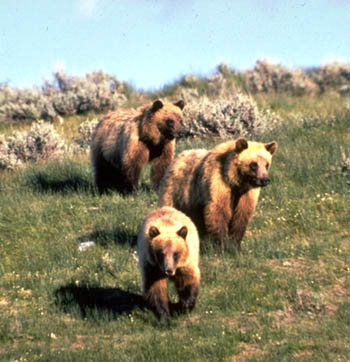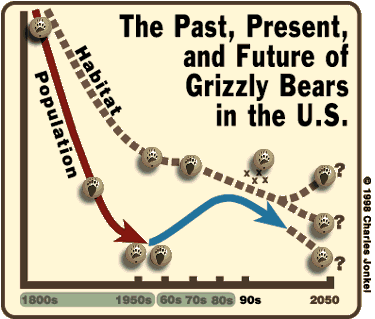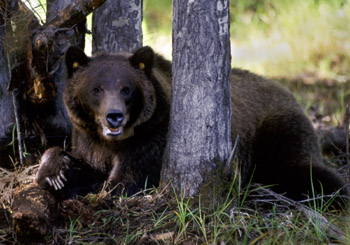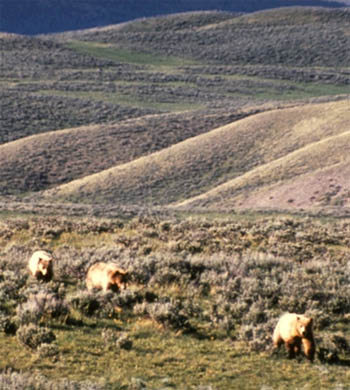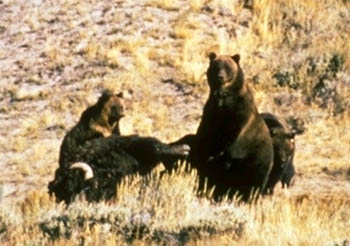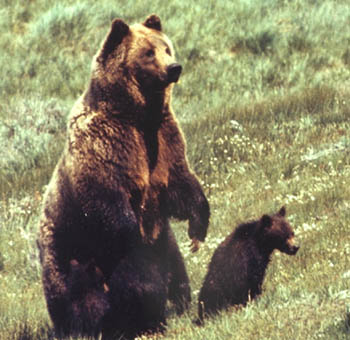The Lurid Details
The anecdotes about their experiences with grizzly bears which the members of the Corps of Discovery brought home were gory enough to guarantee they would be passed along. For people who were outside the loop of the “jawbone journals,” a man named Brackenridge drove the legend of the grisly man-eater deep into American folklore.
Henry Marie Brackenridge (1786-1871) was a prominent attorney, and a lifelong student of Indian life, geography, and natural history. In 1811, he accompanied Manuel Lisa, of the Missouri Fur Company, on a whirlwind trip to the latter’s fort on the Yellowstone River. His book, Views of Louisiana Together with a Journal of a Voyage up the Missouri River, was published in 1814, the same year that the first edition of the Lewis and Clark journals appeared.
With the kind of awe-struck exaggeration and delicious distaste that we reserve for our most notorious monsters, Brackenridge painted the grizzly bear in lurid detail. “This animal, is the monarch of the country which he inhabits. The African lion, or the tyger of Bengal, are not more terrible or fierce. He is the enemy of man; and literally thirsts for human blood. So far from shunning, he seldom fails to attack; and even to hunt him.”
Brackenridge then paraphrased Lewis’s record of the way the Indians prepare for a grizzly-bear hunt, and quoted the measurements Clark recorded of the bear he and Drouillard brought down on 5 May 1805, with ten bullets. Clark had estimated the beast weighed 500 pounds, but Lewis thought it was closer to 600. “Manuel Lisa,” Brackenridge continued, “informed me that they sometimes exceed 1,200 lbs. in weight, and that one full grown, will commonly weigh eight or nine hundred.”
The grizzly bear, Brackenridge concluded, “is sufficient to disprove, the idle theories of Buffon . . . as to the impotency of the NEW WORLD in the production of animals.”[1]Georges Buffon (1707-1788) was a French naturalist and author of Histoire naturelle, générale et particulière, in 44 volumes. Owing to its climate, Buffon wrote, the New World could “nourish … Continue reading At any rate, the picture drawn in the words of Lewis and Clark and their men, as colored by Henry Brackenridge, survives in the minds of many people to this very day. President Theodore Roosevelt, at the turn of the 20th century, was of the opinion that the name “grisly,” meaning horrifying or ghastly, was more suitable for the beast than “grizzly,” which only means grey, or “grizzled.” More recently, those old beliefs have been reinforced in the Hollywood caricature of the “horrible” grizzly bear, The Edge (20th Century Fox), featuring Anthony Hopkins and Alec Baldwin, and starring a neatly-groomed, well-trained animal named Bart the Bear.
The Facts
To see descriptions, point to any data point on the graph.
Ancestry
- Most recent carnivore to evolve (Ursidae): 40 million years
- Distant cousin of dogs (Canidae)
Size (Adult Male Grizzly in Montana)
- Length, 8 feet
- Average weight, 350 to 700 pounds
- Forepaws 5 feet long, 6 feet wide; hind paws 10 feet long, 6 feet wide; claws, 4 feet
- Hump is a mass of muscles for power digging, striking with forepaws
Vision
- Possibly equal to human vision
- Nearsighted, to see food at ground level
- Eyes directed forward; doesn’t need to worry about predators
- Can distinguish colors, though do not see them as humans do
- Good peripheral vision
Hearing
- Fair to moderately good (for a wild animal)
- Far more sensitive than human hearing, in order to locate movements of rodents underground
- Can hear human conversation from 300 meters (that’s 328 yards, or more than 3 football fields away)
Sense of Smell
- The bear’s most important sense, for feeding and defense
- Equal to, or better than, a dog’s. A sheepdog has 220 million olfactory receptors; a human has 5 million.
- Indian saying: “A pine needle fell in the forest. The eagle saw it. The deer heard it. The bear smelled it.”
- Grizzly’s own odor is unique and unforgettable
Diet
- Omnivorous?
- Not a predator of humans; normally does not eat human flesh
Range
- In Lewis and Clark’s era, from Mexico to northern Canada
- Individual bears: 80 to 100 sq mi, depending on quality of habitat
Mobility
- At a lope, 30 miles per hour (44 feet per second)
- Can run about as fast downhill as uphill
Longevity
- Average lifespan, 25 to 30 years
Causes of Mortality
- Loss of habitat
- Diseases (internal parasites)
- Old age (loss of functional teeth; unable to store up enough fat to survive the winter)
Behavior
- Generally shy and peaceful, secretive
- Inquisitive, especially young adults
- Ferocious when provoked
Intelligence
- Seems often to learn from a single experience (food source, threat, trap, rifle shot), and remembers the lesson
- Experiments are being conducted in Montana, Alberta, and Alaska using Karelian dogs, originally bred in Finland to hunt bears, to teach “problem” bears (both grizzlies and black bears) to stay away from humans.
Hibernation
- Hibernates, but body temperature and metabolism do not diminish much
- Dormant or inactive for five to seven months, but can awaken and temporarily leave den
- Do not eat, urinate, or defecate
- Females give birth in January
Common Names
During the winter of 1804-1805, the Lewis and Clark Expedition learned from the Indians to call it the white bear, but among the specimens Lewis sent back to St. Louis from Fort Mandan in the spring of 1805 was “the Skin of a yellow Bear which I obtained from the Scious [Sioux Indians].” Later Lewis changed his mind in mid-sentence, calling it the “brown bear White bear.” Sergeant Ordway observed that the first one Captain Lewis killed was “a Whiteish bair what is called the white bair, but not white but light collour.” Of the same bear, Sergeant Gass reported: “The natives call them white, but they are more of a brown grey.” Ordway later noted one that was “silver grey.”
Clark was the first to invoke the name we now use. On May 5, 1805, he saw “a Brown or Grisley beare,” which he and Drouilliard killed.
On the 13th of June, Lewis drew a tentative conclusion from his observations:
I am induced to believe that the Brown, the white and the Grizly bear of this country are the same species, only differing in color from age or more properly from the same natural cause that many other anamals of the same family differ in colour, one of those which we killed yesterday was of a cream colored white while the other in company with it was of the common bey or redish brown. &the grizly bear we have never yet seen. & I am preswaded if there is any difference between this species and the brown or white bear it is very inconsiderable.
The following year, on 14 May 1806, he hedged a bit:
perhaps it would not be unappropriate to designate them the variagated bear.
The bear we now call “grizzly” has many other names that reflect the backgrounds, attitudes, and experiences of the namers. Among the 87 common names listed by Gary Brown in The Great Bear Almanac (New York: Lyons and Burford, 1993), are bruin (“brown”), chief’s son (Cree Indians), eldest brother (many Native Americans), evil genius, great bear, king of the plains, matohota (Sioux Indians), Moccasin Joe (early frontiersmen), and silvertip.
In times of ursine stress, Meriwether Lewis, with anthropomorphic sympathy, euphemized them all as “gentlemen.”
Scientific Name
The basic method for assigning scientific names that is now used for plants and animals originated with the Swedish naturalist, Carolus Linnaeus (1707-1778), and published in 1758. Known as the Linnean system of classification, it embodied a rational, orderly view of nature, and was one of the principal scientific contributions of the Age of Enlightenment to Western civilization. It organized flora and fauna into hierarchies, in descending order, of kingdoms, phyla, classes, orders, families, genera, and species. Linnaeus used Latin names because that was the international tongue of scholars in his day.
As Lewis and Clark observed and recorded Nature’s progeny along the expedition’s route, they did so with the most rigorous Enlightenment discipline they were capable of, although they had only a general knowledge of the Linnean system of classification. Based on the observable data—the bears’ various colors being the most obvious—Lewis struggled with the problem of field-identification of a species that wasn’t yet in the books.
Formal descriptions, classifications, and admittance into scientific literature, were the responsibilities of scholars back home, such as George Ord (1781-1866), the American naturalist who first used the captains’ journals, and the specimens they collected, to organize the “discoveries” they had made.
Ord classified the captains’ nemesis under the generic name, Ursus, which is Latin for “bear.” He viewed it as a single, separate species, and gave it a designation that wrapped up the journalists’ feelings in one emotion-packed word—”horribilis.”
The grizzly that Lewis and Clark saw is now considered to belong to the same species as the Alaskan brown bear and the Kodiak bear, and is designated as the species arctos—the Greek word for “bear”—and sub-species horribilis. Thus is this group of bears, Ursus arctos, distinguished from the more numerous and less intimidating Ursus Americanus—the black bear. (The latter, not the grizzly, is the model for “Smokey Bear,” and the “Teddy Bear.”)
So today, perhaps merely out of respect for historical tradition, horribilis still identifies the sub-species found in Montana, Wyoming, Idaho, Washington, Alberta, British Columbia, the Northwest and Yukon Territories, and interior Alaska.
Biblical References
Of course, neither the Corps of Discovery nor Henry Brackenridge invented the legend of Ursus arctos horribilis. They merely inked in some more details, which enhanced the fright factor. Fear of bears may well reside deep in the collective subconscious of the human animal, if Biblical authority is any indication. The bear of Palestine, Ursus arctos syriacus, has been extinct since the early 20th century.
There are warnings about annoyed or hungry bears (Amos 5:19), as well as females with cubs (II Kings 2:24), which certainly are still worth heeding.
A she-bear robbed of her cubs is a simile for human anger (II Samuel 17:8; Isaiah. 59:11; Ecclesiastes. 25:17), and for the wrath of God (Hosea. 13:8): “I will meet them as a bear that is bereaved of her whelps, . . . the wild beast shall tear them.”
The bear is Nature’s trope for a wicked ruler (Proverbs, 28:15); for God lying in wait (Lam. 3:10); for the prowess of David the shepherd (I Samuel 17:34, 36-37; and for the coming age of peace (Isaiah 11:7).
Could a frontier preacher have overlooked the suitability of the metaphor of the fabled grizzly to drive his message of divine retribution deep under the skins of westering sinners? Two Old Testament figures were names to hang the lesson on, and there was more to their stories than just names for a beast.
Ephraim (Genesis 48) was leader of the Ephraimites, the most warlike of the twelve tribes of Israel. Their land was bordered on the east by the Jordan River, on the west by the Mediterranean Sea. (The last grizzly in the state of Utah, trapped and shot by a sheepherder in 1923, was an 1,100-pound, 9 foot 11 inch livestock killer known as “Old Ephraim.”)
Moses gave the land of Canaan to Caleb (Numbers 13-14), who was the leader of the tribe of Judah. “Old Caleb,” the grizzly, was anointed custodian of the American West, the Garden of the World, the new Promised Land, “which floweth with milk and honey.”
Finally, for all modern defenders of the endangered species, Ursus arctos horribilis, it is King Solomon’s wisdom (Proverbs 17:12) which offers words to crusade by: “Better to meet a she-bear robbed of its cubs than to confront a fool immersed in folly.”
Amen!
Indian Perspectives
Bears in general held a special place in American Indian cultures, because they resemble people in certain ways. They eat the same types of food. They stand on their hind legs, and sometimes walk upright, their forelegs hanging like arms. And of course they are sometimes impossible to deal with. Bears are half human, some Indians say; “humans without fire,” say others. The Blackfeet word o-kits-iks stands for both the human hand and a bear’s paw. The Ojibwa often refer to bears as anijinabe, the same word they use to describe themselves.
But not all Indians regard all bears in the same way. The Blackfeet call a black bear kyaio, which means bear; the grizzly they call nitakyaio, which means real bear.
Tribes who live in the mountains, where there were few buffalo or elk in the old days, would eat black bears, but not grizzlies. The latter were definitely more powerful and dangerous, and were to be avoided, or at least treated with the greatest respect and deference—spoken of in a low voice.
As Meriwether Lewis observed in his journal for 13 April 1805:
When the Indians are about to go in quest of the white bear, previous to their departure, they paint themselves and perform all those supersticious rights commonly observed when they are about to make war uppon a neighbouring nation.
To get power from a bear by dreaming of one, by killing and eating part of one, or even by touching a bear, made a warrior invincible. Among the Shoshonis, though, the the man with a grizzly for a guardian spirit was considered likely to have a short temper.
Further Reading
David Rockwell, Giving Voice to Bear (Niwot, Colorado: Roberts Rinehart, 1991).
Notes
| ↑1 | Georges Buffon (1707-1788) was a French naturalist and author of Histoire naturelle, générale et particulière, in 44 volumes. Owing to its climate, Buffon wrote, the New World could “nourish only cold men and weak animals.” Animals in America were “smaller than their equivalents in the old world,” bred as they were “under this spare sky on this empty earth.” Actually, Thomas Jefferson, himself a pioneering paleontologist, had already set Buffon straight on the matter. |
|---|
Experience the Lewis and Clark Trail
The Lewis and Clark Trail Experience—our sister site at lewisandclark.travel—connects the world to people and places on the Lewis and Clark Trail.
Discover More
- The Lewis and Clark Expedition: Day by Day by Gary E. Moulton (University of Nebraska Press, 2018). The story in prose, 14 May 1804–23 September 1806.
- The Lewis and Clark Journals: An American Epic of Discovery (abridged) by Gary E. Moulton (University of Nebraska Press, 2003). Selected journal excerpts, 14 May 1804–23 September 1806.
- The Lewis and Clark Journals. by Gary E. Moulton (University of Nebraska Press, 1983–2001). The complete story in 13 volumes.
